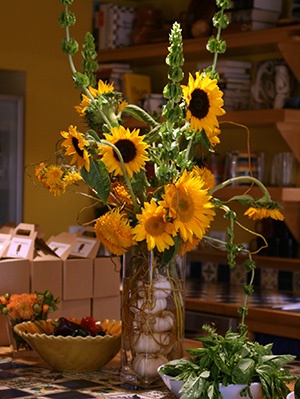Cut Flower Care

Whether you favor a single flower in a tiny vase, a handful of carefully selected blooms, or large floral arrangement, it’s important to properly care for your cut flowers.
Proper care for your cut flowers can keep them looking fresh and beautiful for longer. Begin by removing the bottom-most leaves from your flower stems. The goal is to remove any leaves that would end up submerged in water while in the vase.
Except for those leaves below the water line, you actually want to leave as much foliage on the stems as possible. Because it’s through the leaves that transpiration occurs; transpiration is what drives water up the stems of the flowers. So only remove broken or damaged leaves and those below the water line.
While we’re on the topic of removal, some people suggest removing or dulling thorns to increase the vase-life of roses. In fact, the opposite is true—removing thorns damages stems; this essentially causes a wound, providing an entry point for microbes.
Once you’ve removed the leaves you need to, cut about an inch off the bottom of the stem. Be sure to use a clean knife or clippers and choose a tool that will give you a clean cut without crushing the stem. This is an important step as cutting a fresh inch off the stems allows water to be taken up by the plants more easily.
Before putting the flowers into water, add some floral preservative (sometimes called flower food) to the water in your vase. While there are many homemade flower “food” concoctions, the commercial mixtures work best at controlling microbial populations and hydrating stems—keeping your flowers looking great for longer.
If you notice the solution in your vase becoming cloudy, remove the flowers, re-cut the stems, and replace the flowers in the vase with a fresh mixture.
Now your cut flowers are ready for display. They should be kept out of direct sunlight and in a cool place to help them retain moisture. If your arrangement is in the kitchen, be sure to keep your cut flowers away from the fruit bowl; ripening fruit emits ethylene gas that will age the flowers more rapidly.
